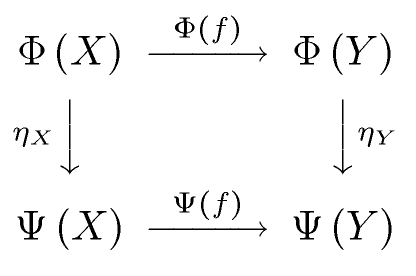Category theory/Natural transformation
Jump to navigation
Jump to search
Example:
Example: maybeToList
maybeToList map even $ maybeToList $ Just 5
yields the same as
maybeToList $ fmap even $ Just 5
yields: both yield
[False]
Commutative diagram
Let , denote categories. Let be functors. Let us define the natural transformation.
............
Vertical arrows: sides of objects
… showing how the natural transformation works.
maybeToList :: Maybe a -> [a]
Left: side of X object
maybeToList :: Maybe Int -> [Int]
| |
Nothing
|
[]
|
Just 0
|
[0]
|
Just 1
|
[1]
|
Right: side of Y object
maybeToList :: Maybe Bool -> [Bool]
| |
Nothing
|
[]
|
Just True
|
[True]
|
Just False
|
[False]
|
Horizontal arrows: sides of functors
even :: Int -> Bool
Side of functor
fmap even:: Maybe Int -> Maybe Bool
| |
Nothing
|
Nothing
|
Just 0
|
Just True
|
Just 1
|
Just False
|
Side of functor
map even:: [Int] -> [Bool]
| |
[]
|
[]
|
[0]
|
[True]
|
[1]
|
[False]
|
Commutativity of the diagram
both paths span between
Maybe Int -> [Bool]
| ||
map even . maybeToList
|
maybeToList . fmap even
| |
Nothing
|
[]
|
[]
|
Just 0
|
[True]
|
[True]
|
Just 1
|
[False]
|
[False]
|
Remarks
evenhas a more general type (Integral a => a -> Bool) than described here- Words “side”, “horizontal”, “vertical”, “left”, “right” serve here only to point to the discussed parts of a diagram, thus, they are not part of the scientific terminology.
- If You want to modifiy the #Commutative diagram, see its source code (in LaTeX using
amscd).
External links
- The corresponding HaWiki article is not migrated here yet, so You can see it for more information.
- Wikipedia's Natural transformation article
